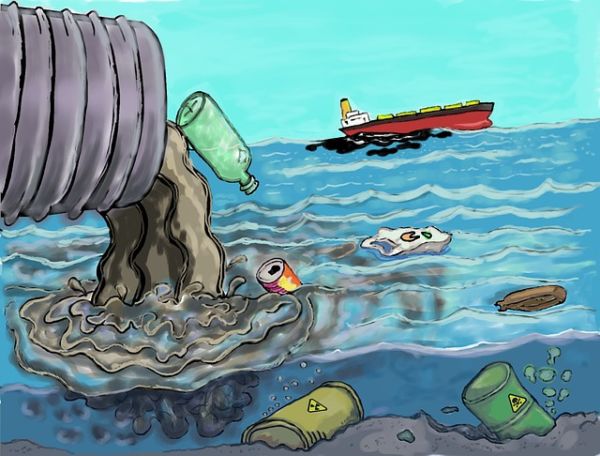Ocean pollution is the contamination of ocean. Like all other pollution Ocean pollution is also one of the challenges before us. We know this pollution are not reversible at any cost but still continue doing it. We shall discuss the effects of Ocean pollution in detail here in this article as we have already discussed about Ocean pollution and its causes.
What are the effects of ocean pollution?
The contamination of the oceans have effects on the aquatic life forms, plants, beaches, ecosystems and humans and much more as is being discovered now.
- Addition of chemicals is changing the chemical nature and equations in the waters. New toxic substances are formed in the presence of water, salt and sunlight. These are ingested by the organisms and accumulate in their bodies and enter the food chain.
- Plastics are also ingested and as they break down a carcinogenic toxin Bisphenol A is released which enters the food chain too.
- Another effect of ingestion of plastic is slow starvation and death of fish mammals and birds. Plastic debris is mistaken for food and swallowed. These remain undigested filling up the stomachs and intestines. After a while the animals cannot feed anymore as there is no space in their digestive organs. They slowly starve to death. Birds are seen sorting among debris and ingesting brightly coloured plastic bits. Fish mistake floating debris as plankton or krill and swallow them. Larger mammals eat the smaller fish indirectly taking in the debris that is in them. When hundreds of bird and animal carcasses lie on the beaches, it is obvious what killed them. The whole bodies rot, but the plastics in the stomach are still intact.
- Marine debris settle down to the ocean floors and sea beds. These create deadly traps under water. Discarded plastic fishing nets are a good example of this. Large fish, seals, dolphins, and other mammals are entangled in them and suffocate to death.
- Coral reefs are called the rainforests of the sea because they shelter many species of aquatic creatures. Coral reefs are living organisms. Marine debris that are large and moved around by ocean currents harm them physically by knocking off parts of them and damaging the reefs. Coral reefs are also harmed by the chemical changes in their surroundings. Other practices that harm these fragile ecosystems are temperature change, ocean acidification, fishing, overuse of reef resources by tourism and nutrient enrichment as a result of agricultural runoff
- Dead Zones or hypoxic areas are a consequence of land or agriculture pollution. When nitrogen and phosphorus compounds reach bodies of water they create a nutrient rich environment here which encourages algae to grow on the surface of the water. When the algae bloom they use up all the oxygen in the water leaving very little for any other life form. They also block the sunlight from reaching the water bed and hence prevent the photosynthesis in plants; as a result Oxygen levels are not replenished. The water in this part of the sea or ocean becomes unfit for living in. This is called Eutrophication. Those that cannot move away in time die. Those who can escape to better conditions move away. Untreated wastewater from sewage and industry also contribute to eutrophication.

Dead Zones are found near the inhabited coastlines. The Chesapeake Bay on the east coast of US was one of the first dead zones discovered in 1970s. The Gulf of Mexico has a hypoxic zone forming every summer. Its size varies from 5000 to 22000 sq km. the Baltic Sea has at least 10 dead zones.
- Garbage patches – The Great Pacific Garbage patch was identified between 1985 and 1988. This was found in the Pacific Ocean Gyre; A large collection of marine debris consisting more percentage of plastic floating around in the still calm waters of the gyre. It reached here because of the circulating ocean currents and global wind patterns that caused the garbage to accumulate at a point. It is expected to find a garbage patch in each of the other four oceans. As much as plastic is seen above the water level there is a huge amount below the surface too creating a deadly plastic soup. The plastic that does not degrade becomes as small as zoo plankton and consumed by every other creature in the seas.
- Oil spillage. Most of the oil in the sea comes from the land. It causes great damage to the environment. Over water it creates a thin layer over the ocean surface over a larger area than it would on the land. Oil coats the plumage of birds and the fur of animals making them loose their thermal protection and less buoyant. They ingest the oil while preening their feathers; digestive organs liver and kidneys are destroyed. It even coats the shell fish suffocating them. Oil causes blindness in animals leaving them defenceless. It costs a lot to clean up. Some of the famous ones are the Deep water Horizon Oil Spill and the Exxon Valdez Oil Spill.
- Radiation pollution – some of the bodies of water used as dumps are Irish Sea (British), English channel( French) , Arctic Ocean , Kara Sea and Barents Seas ( Russians). More recently the tsunami hit Fukushima in Japan was in the news as the damage released tons radioactive material directly into the seas. Radioactive elements are absorbed by plankton kelp and other marine life and will then move up the food chain
As vast as the oceans so vast will be the effects of its pollution. Loss of many beneficial and beautiful places and species cannot be reversed. Many organisations, governments and agencies are researching and developing new technologies to reduce and control ocean pollution. The cost to clean up the ocean is huge and is a burden that must be shared. But that share doesn’t happen even though the share of polluting it is being fulfilled.
